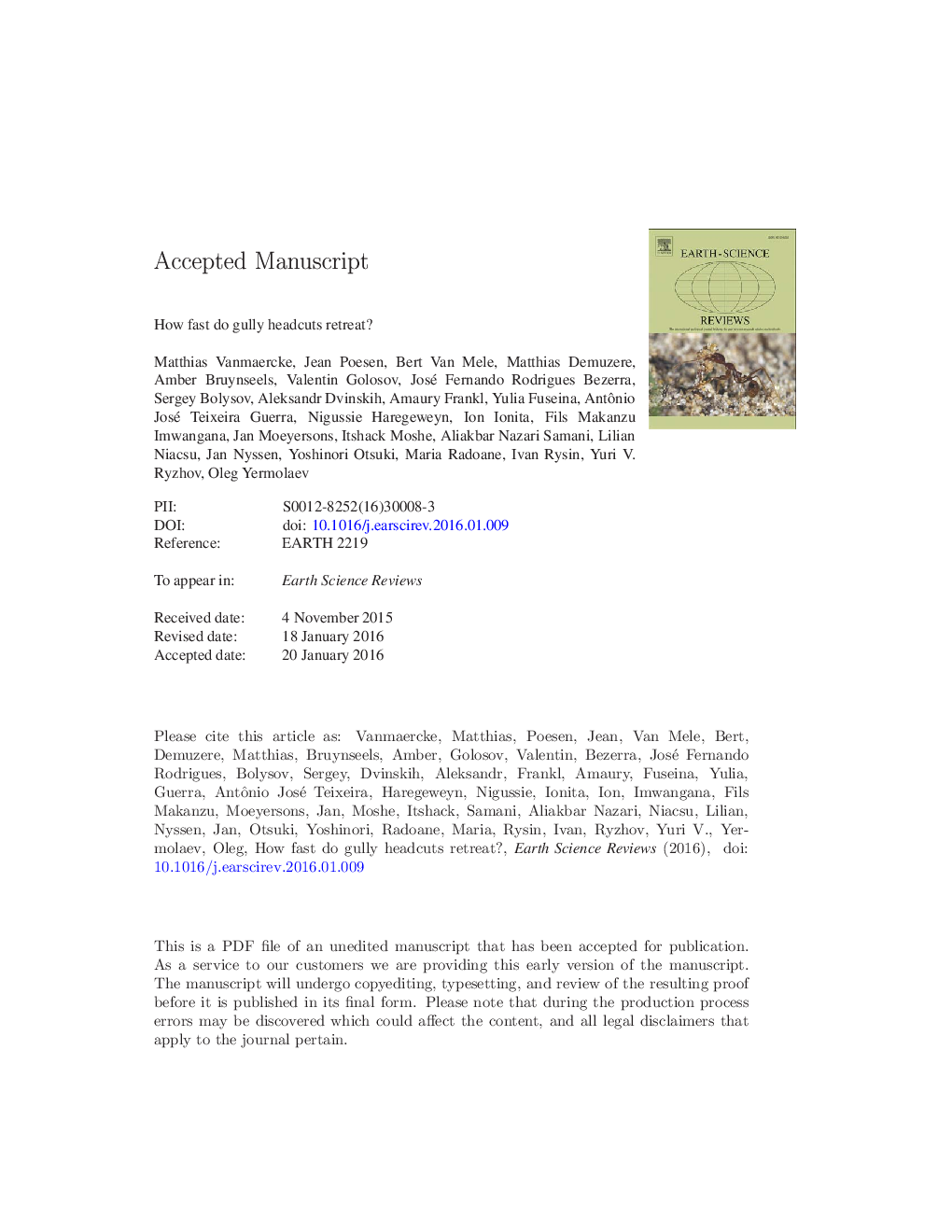| کد مقاله | کد نشریه | سال انتشار | مقاله انگلیسی | نسخه تمام متن |
|---|---|---|---|---|
| 6442989 | 1639948 | 2016 | 52 صفحه PDF | دانلود رایگان |
عنوان انگلیسی مقاله ISI
How fast do gully headcuts retreat?
ترجمه فارسی عنوان
چقدر سریع سر و صدا می کند؟
دانلود مقاله + سفارش ترجمه
دانلود مقاله ISI انگلیسی
رایگان برای ایرانیان
کلمات کلیدی
فرسایش کوهی، جمع آوری اطلاعات، تجزیه و تحلیل جهانی، مدل، تاثیر آب و هوا، تنوع زمانی،
موضوعات مرتبط
مهندسی و علوم پایه
علوم زمین و سیارات
زمین شناسی
چکیده انگلیسی
Gully erosion has important on and off site effects. Therefore, several studies have been conducted over the past decades to quantify gully headcut retreat (GHR) in different environments. Although these led to important site-specific and regional insights, the overall importance of this erosion process or the factors that control it at a global scale remain poorly understood. This study aims to bridge this gap by reviewing research on GHR and conducting a meta-analysis of measured GHR rates worldwide. Through an extensive literature review, GHR rates for 933 individual and actively retreating gullies have been compiled from more than 70 study areas worldwide (comprising a total measuring period of > 19 600 years). Each GHR rate was measured through repeated field surveys and/or analyses of aerial photographs over a period of at least one year (maximum: 97 years, median: 17 years). The data show a very large variability, both in terms of gully dimensions (cross-sectional areas ranging between 0.11 and 816 m2 with a median of 4 m2) and volumetric GHR rates (ranging between 0.002 and 47 430 m3 yearâ1 with a median of 2.2 m3 yearâ1). Linear GHR rates vary between 0.01 and 135 m yearâ1 (median: 0.89 m yearâ1), while areal GHR rates vary between 0.01 and 3628 m2 yearâ1 (median: 3.12 m2 yearâ1). An empirical relationship allows estimating volumetric retreat rates from areal retreat rates with acceptable uncertainties. By means of statistical analyses for a subset of 724 gullies with a known contributing area, we explored the factors most relevant in explaining the observed 7 orders of magnitudes of variation in volumetric GHR rates. Results show that measured GHR rates are significantly correlated to the runoff contributing area of the gully (r2 = 0.15) and the rainy day normal (RDN; i.e. the long-term average annual rainfall depth divided by the average number of rainy days; r2 = 0.47). Other factors (e.g. land use or soil type) showed no significant correlation with the observed GHR rates. This may be attributed to the uncertainties associated with accurately quantifying these factors. In addition, available time series data demonstrate that GHR rates are subject to very large year-to-year variations. As a result, average GHR rates measured over short (< 5 year) measuring periods may be subject to very large (> 100%) uncertainties. We integrated our findings into a weighted regression model that simulates the volumetric retreat rate of a gully headcut as a function of upstream drainage area and RDN. When weighing each GHR observation proportional to its measuring period, this model explains 68% of the observed variance in GHR rates at a global scale. For 76% of the monitored gullies, the simulated GHR values deviate less than one order of magnitude from their corresponding observed value. Our model clearly indicates that GHR rates are very sensitive to rainfall intensity. Since these intensities are expected to increase in most areas as a result of climate change, our results suggest that gully erosion worldwide will become more intense and widespread in the following decades. Finally, we discuss research topics that will help to address these challenges.
ناشر
Database: Elsevier - ScienceDirect (ساینس دایرکت)
Journal: Earth-Science Reviews - Volume 154, March 2016, Pages 336-355
Journal: Earth-Science Reviews - Volume 154, March 2016, Pages 336-355
نویسندگان
Matthias Vanmaercke, Jean Poesen, Bert Van Mele, Matthias Demuzere, Amber Bruynseels, Valentin Golosov, José Fernando Rodrigues Bezerra, Sergey Bolysov, Aleksandr Dvinskih, Amaury Frankl, Yulia Fuseina, Antônio José Teixeira Guerra,
